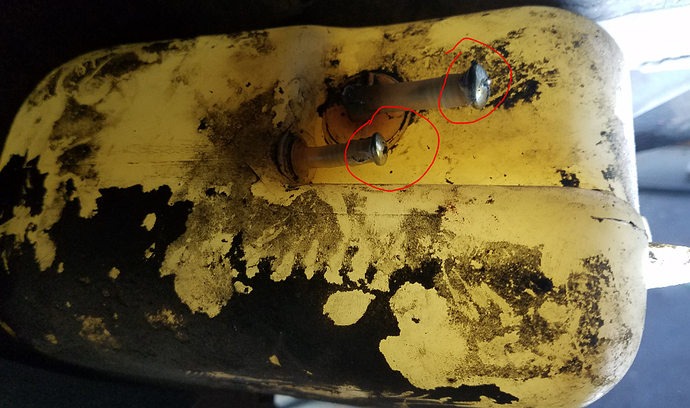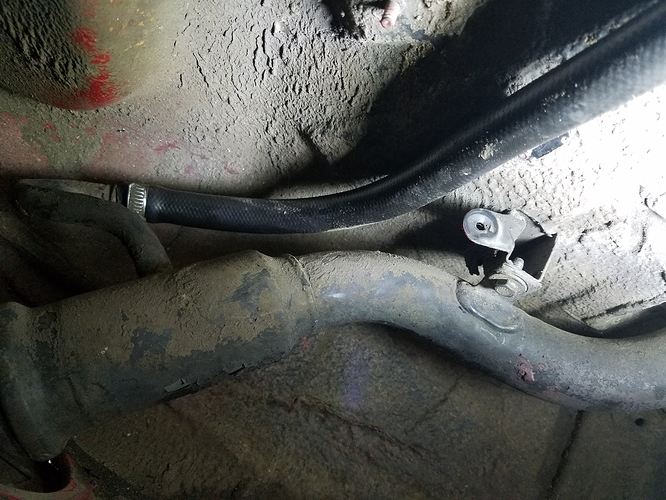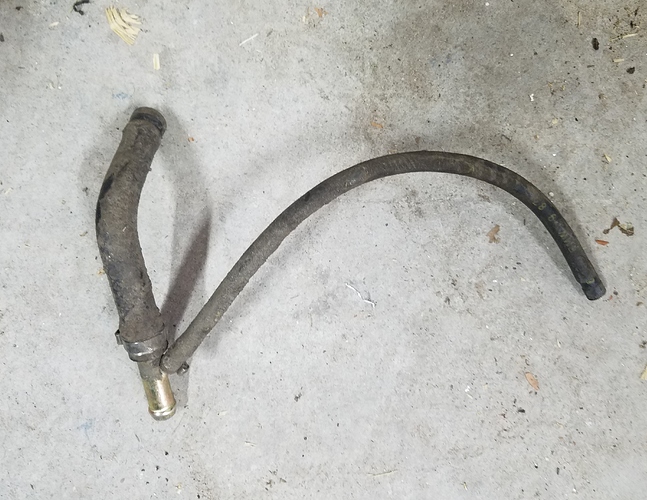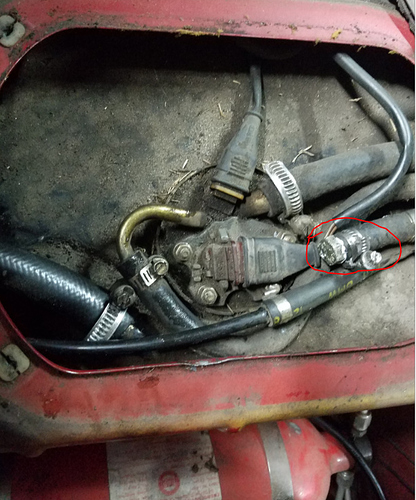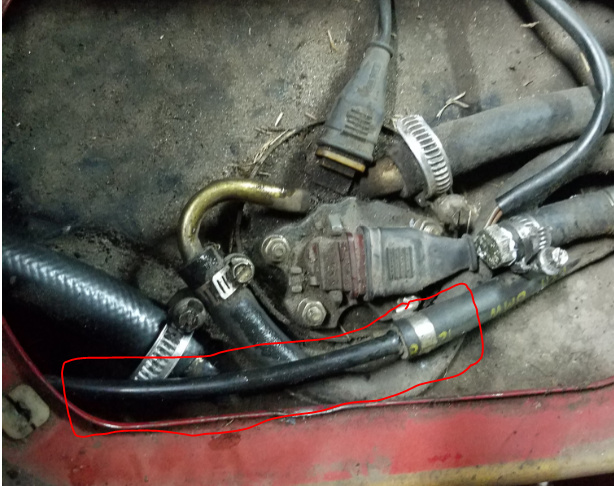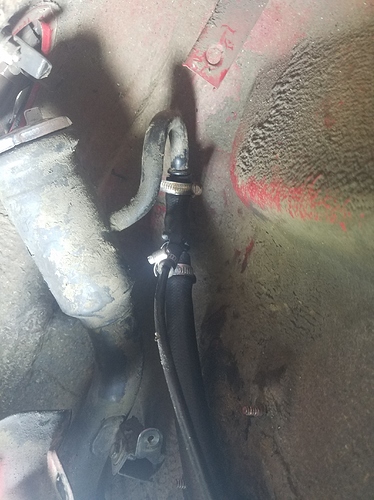I had some problems with fuel sloshing out from near the cap. I could smell it, and a video from a buddy made the general vicinity of the problem clear. I decided to look into the fuel venting system and see if there was some obvious problem that said “I’m the leak.” The reason I went after the fuel venting system is that I tried 3 different fuel caps and the problem persisted. Besides, I’ve long known I had a venting system problem because I have to use a vented fuel cap or my gas tank becomes a low pressure zone.
Summary.
-
The problem was probably serially bad fuel caps.
-
The system under the RR fender isn’t about venting, it’s about gas vapor expansion. The closest thing to a vent is the hose that goes forward up to the engine bay carbon canister that most of us have deleted. If that hose is plugged anywhere you probably don’t have any venting going on at all.
-
The best solution, imo, is a vented gas cap, but it relies on hose #5 being sound.
-
As always, I talk as if this is all fact, but it’s really just my opinion. I didn’t design this shit, I just spent the last couple evenings trying to understand what I was seeing.
Here’s a diagram from RealOEM for an early E30. The diagram shows part #s well, but it’s got some flaws, which I tried to circle.
-
Part # 11 is a steel tube that goes across the gas tank so it’s location in the pic is deceptive.
-
Part #'s 10 and 3 don’t actually connect, like the diagram seems to depict. 10 is for vapor to the carbon canister. #3, that particular #3, is for vapor that has condensed into fuel and is a return to the tank.
-
Part #3 doesn’t go to the tank near the lift pump like the diagram depicts. Instead, it connects to a steel tube that goes across my gas tank. I don’t know what the hell it connects to and I don’t care. No fuel is gonna end up in the expansion tank that needs returning from the expansion tank bottom. I was tempted to remove the plastic hose and plug the steel pipe, but I left it alone. Note that there are several part #3’s in the diagram.
What I did.
- I removed both hoses that went to the top of the expansion tank. One went to the filler pipe and the other goes ultimately to the carbon canister in the engine bay. The hoses were plastic, not rubber. I did this for a couple reasons. Because I was chasing a leak, I wanted to remove hoses that didn’t seem useful. Also, removing the plastic hose meant more room in that steel pipe that the hose #5 had to go thru and I was having problems getting hose #5 in place.
I plugged both ports at the top of the expansion tank.
Note that the plastic hose from expansion tank to filler pipe won’t vent squat unless you have a vented gas cap.
Because the rules say we can remove the carbon canister and associated hoses, I felt like the rules covered me. The 2 little plastic hoses were “associated.”
- I replaced the hose #5. You can see the new hose in the below pic. My hose was in such terrible shape that it was hard to tell if would still hold liquid or not. The hose was a strange fibrous mesh, as tired and ratty as you can possibly imagine. It struck me that even tho it had no visible hole, because it was a fibrous mesh, the whole damned thing could be leaking like a sieve, for all I knew.
The hose was not easy to get thru the pipe that goes into the interior of the car. No amount of lube would see it thru. I’m sure this step is easy if you drop your fuel tank, but I was determined to avoid that. Ultimately the way I got it done was to thread the carbon cannister’s plastic vent hose, it’s the 6mm one, not the 8mm mystery plastic hose, and then thread, or maybe “sleave” would be a better word, the 14mm hose along after it. The 6mm hose, inside of the 14mm hose acted as a guide for the larger hose.
I could not find the right dia hose locally. 9/16th would have done it, but I couldn’t find that either. If you go down this path, find a hose with a thin wall. The hose needs to be pliable to get over the connections and flatten down where it goes past the rear strut. https://www.amazon.com/gp/product/B07XJPHW91/ref=ppx_yo_dt_b_asin_title_o00_s00?ie=UTF8&psc=1
Instead of the 14mm hose going to a T that connects to hose 3 coming from the expansion tank, I ran the 14mm hose right to the steel loop coming out of the filler pipe. This is a no shit vent hose. It goes from the top of the filler pipe to the top of the tank. But it can only vent if you have vented gas cap.
This is a pic of the T that was removed. Don’t throw this away. After reading the next post, you might want to keep it. Doesn’t need to be connected to the expansion tank tho, connect it to hose 5 and the plastic pipe that goes to the driver’s side of the gas tank.
- At the lift pump I plugged the pipe that ultimately goes to the engine bay carbon canister, call it hose 7 on the confusing OEM drawing. At least, ah, I think that is where it goes to the carbon canister.
So here’s how I think this stuff is supposed to work.
When gas vapor in the tank gets warm and wants to go somewhere, it can go out hose 5. If you have a vented gas cap, the over-pressure can then escape. If you don’t have a vented gas cap, the T near the filler cap allows the over-pressure to expand, via hose 3, into the expansion tank. Not a big volume, but better then blowing a hose due to over-pressure.
Any fuel that condenses in the expansion tank can return to the tank via hose 3-7-3.
What really got my attention is that I was unable to ID anything that would allow air to come into the tank, so that the removed fuel doesn’t start trying to create a vacuum in there. Several fuel caps ago I had one that, when I removed it after a track session, there’s be a big sucking noise into the gas tank. Not only did I suck, but so did my gas tank. After that I bought a venting gas cap, but I noted that they don’t seem to vent but a year or two and then they plug up, or something.
So I’m thinking that our fuel system was designed for a vented gas cap. Then, years after production ended, the EPA probably forbid them, and that’s why so many of the gas caps today are non-venting.



